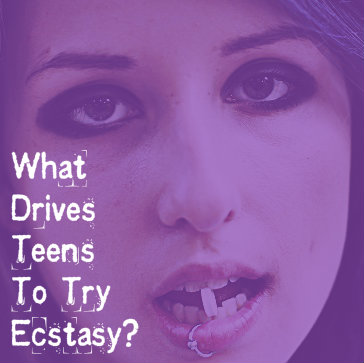What Drives Teens To Try Ecstasy?
Ecstasy is a widespread term used for MDMA or Molly, an illegal amphetamine-like drug that also has some of the properties of hallucinogenic substances. In a study published in October 2013 in the journal Addiction, a multi-institution Australian research team examined some of the main factors that drive involvement in Ecstasy use. These researchers found that the critical factors include one’s social environment, previous history of drug use and level of a mental state called psychological distress.
Effects And Details Of Ecstasy
 The full chemical name of Ecstasy (MDMA) is methylenedioxymethamphetamine. Outside of very limited situations, manufacturers produce this substance illegally, and distributors also usually sell it outside of legal channels. The stimulant effects of Ecstasy produce alertness and high levels of energy, while the hallucinogen-like effects of the drug produce an impaired ability to track the passing of time and unusual sensitivity to sound and touch. In addition, the drug commonly produces a benevolent mental outlook and an increased sense of social/spiritual connection with others. Ecstasy users typically view these physical and psychological changes as the drug’s desirable effects.
The full chemical name of Ecstasy (MDMA) is methylenedioxymethamphetamine. Outside of very limited situations, manufacturers produce this substance illegally, and distributors also usually sell it outside of legal channels. The stimulant effects of Ecstasy produce alertness and high levels of energy, while the hallucinogen-like effects of the drug produce an impaired ability to track the passing of time and unusual sensitivity to sound and touch. In addition, the drug commonly produces a benevolent mental outlook and an increased sense of social/spiritual connection with others. Ecstasy users typically view these physical and psychological changes as the drug’s desirable effects.
The use of Ecstasy is heavily associated with attendance at parties or dances that feature some form of electronic music; however, use can also take place in a range of other settings. The drug disrupts the body’s ability to regulate its internal temperature. In combination with the high, external body heat levels commonly found at the parties and dances where Ecstasy use occurs, this temperature dysregulation can lead to a dangerous, sometimes lethal condition called hyperthermia, which sets in when the body’s temperature rises above a sustainable level. Additional, major short-term health problems associated with Ecstasy intake include seizures and the development of significant heartbeat instability. Typically, people who take large amounts of the drug in a short span of time have the highest risks for experiencing these problems.
Psychological Distress And Ecstasy
Psychological distress is a term used to describe the presence of a range of emotional states that can undermine a person’s sense of mental well-being. Examples of these emotions include nervousness, hopelessness, restlessness and a “down” mood. By itself, psychological distress does not constitute a diagnosable mental health disorder. However, the underlying effects of a distressed psychological outlook are known contributors to the development of a number of diagnosable mental illnesses, including schizophrenia, bipolar disorder, anxiety disorders and major depression. According to figures compiled by the federal Substance Abuse and Mental Health Services Administration (SAMHSA), young adults experience psychological distress considerably more often than middle-aged adults or elderly adults, and also receive help for their condition less often than adults in these age groups.
Social Environment, Past Drug Use – Factors In Ecstasy Use
In the study published in Addiction, researchers from five Australian institutions used an assessment of 204 young adults between the ages of 19 and 23 to look at the factors that contribute to the start of participation in Ecstasy use. At the beginning of the study, none of these adults had used Ecstasy; however, over 40 percent of them had been offered the drug at some point. Six months later, the researchers identified the participants who had eventually accepted an offer to take Ecstasy and examined the reasons for this change in behavior.
After completing their assessment, the researchers concluded that factors related to an individual’s social environment played the most prominent role in the onset of Ecstasy use among the study’s young adults. Specific factors cited include having social interactions with a lot of people who already use the drug and attending the electronic music/dance events classically associated with Ecstasy use. The presence of the symptoms of psychological distress also played a meaningful role, as did a previous history of using marijuana or other forms of cannabis. However, these factors did not rise to the same level of importance as social environment.
How Study Results Can Help Ecstasy Drug Education
The authors of the study published in Addiction believe that their research can play a role in efforts aimed at curbing the use of Ecstasy and warning users about the drug’s major pitfalls. If successful, such efforts would likely have two components: a large-scale education campaign designed to reach broad segments of the population and a smaller, more targeted campaign designed to reach young adults and other individuals exposed to known risk factors for Ecstasy use.



